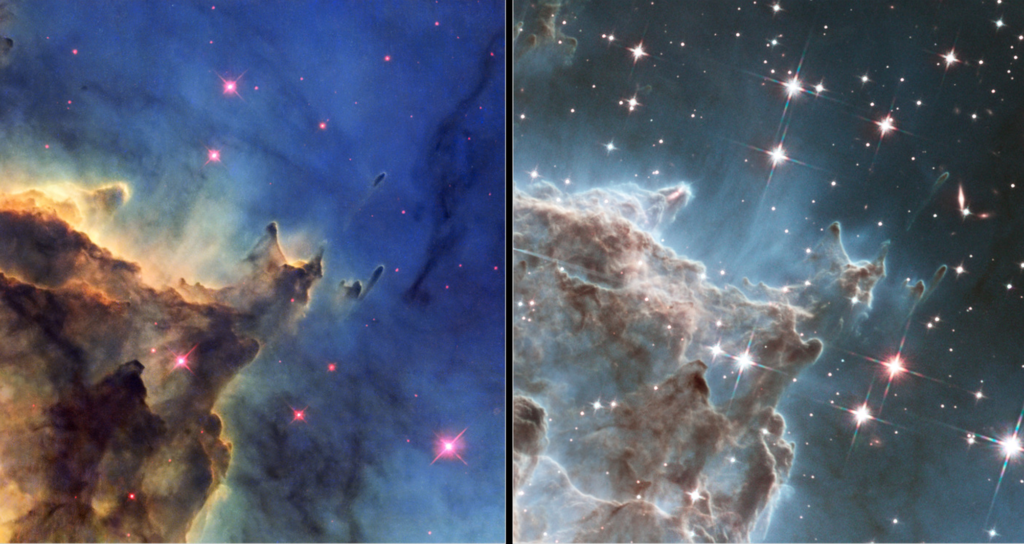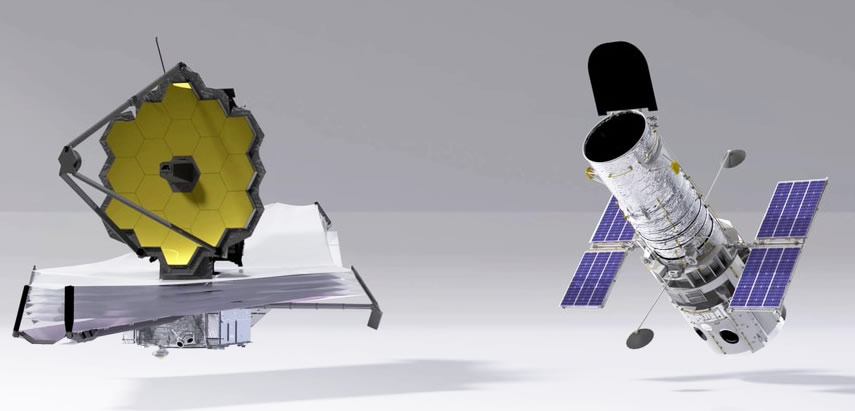
What Are The Differences Between Webb & Hubble?
With the James Webb Space Telescope well on its way to L2, assuming everything goes according to plan, we will be provided with some of the most incredible images and information about the history of our universe and more. More than 30 years ago in 1990, the Hubble Telescope was launched into space with similar goals and excitement. However, after a long time, technology along with our understanding has changed and caused some major differences between these two telescopes.
There is a long list of differences between the JWST and Hubble that each serves a specific purpose and goal. Some of the main differences between the space telescopes include the distance each telescope can see, the wavelength, size, and more. All of which combine to make Webb stand out from previous telescopes such as Hubble. These same changes are meant to expand our knowledge and understanding of the universe we live in.
The Hubble Telescope was considered a marvel of technology when launched into space. Escaping Earth’s atmosphere provided invaluable information that we never had access to prior. While the telescope did not have the smoothest operation at first, it soon was serviced, repaired, and capable of taking beautiful photos. This has helped it continue to be in operation over 30 years later now in 2022.
JWST & Hubble Background

Right now, the James Webb Space Telescope is on its way to L2 and nearing the end of its deployment phase. As for the Hubble, it’s still orbiting Earth right now around 570km from the surface. While Webb has only been in space for a few weeks now, the Hubble has been orbiting our planet and taking photos for over three decades. Oftentimes people call the JWST a replacement for Hubble but NASA calls it a successor. Webb’s science goals along with many different decisions made throughout the telescope were motivated by results from Hubble. Its science pushed us to look to longer wavelengths and see further into space than what Hubble was capable of. Specifically, more distant objects are more highly redshifted, and their light is pushed from the UV and optical into the near-infrared.
This means that observations of these distant objects such as early galaxies and more require an infrared telescope. Another reason that the JWST is not a replacement for Hubble is due to the fact that the telescope’s capabilities are not identical. Webb will primarily look at the Universe in the infrared, while Hubble studies it primarily at optical and ultraviolet wavelengths. In addition, there is also a large list of major differences between both telescopes such as size, distance, and more that play into the role of whether or not Webb is a replacement or not. In the end, the goal is for both telescopes to be fully operational and continue to take invaluable images. The Universe is very big and there are plenty of things for both telescopes to observe and capture.
Telescope Differences

View Distance – The first major difference between the two space telescopes is the distance each can see. Light takes time to travel which means the farther away an object, the farther back in time we are looking. When comparing Hubble and Webb, there are some big differences in what each telescope is expected and can see. Hubble can see the equivalent of toddler galaxies and Webb is expected to be able to see baby galaxies. One of the reasons for the JWST’s extended range has to do with it being an infrared telescope. The Universe is expanding which includes the galaxies within it.
Einstein’s General Relativity comes into play and tells us that the expansion of the universe means it is the space between objects that actually stretches, causing objects to move away from each other. In relation to these two telescopes, any light in that space will also stretch, shifting that light’s wavelength to longer wavelengths. This has the effect of making distant objects very dim or even invisible at visible wavelengths of light because the light reaching us is now infrared. Due to Webb being an infrared telescope, it’s ideal for observing these early galaxies that no longer can be seen using visible light. Overall the James Webb Space Telescope will see farther into the past of the Universe than any other telescope including Hubble.
Wavelength – The next big difference between Webb and Hubble that I partially mentioned prior has to do with wavelengths. As we know the JWST will observe primarily in infrared. It will have four science instruments to capture images and spectra of astronomical objects. These instruments will provide wavelength coverage from 0.6 to 28 micrometers or microns. A single micron is 1.0 times 10 to the negative 6th meters. The infrared part of the electromagnetic spectrum goes from about 0.75 microns to a few hundred microns. This means that Webb’s instruments will work primarily in the infrared range of the electromagnetic spectrum, with some capability in the visible range. Specifically, in the red and up to the yellow part of the visible spectrum.
Taking a look at Hubble, it can observe a small portion of the infrared spectrum from 0.8 to 2.5 microns. However, its primary capabilities are in the ultra-violet and visible parts of the spectrum ranging from 0.1 to 0.8 microns. Looking at the bigger picture of astronomy, infrared observations are an extremely important aspect. Stars and planets that are just forming lie hidden behind cocoons of dust that absorb visible light. However, infrared light emitted by these regions can penetrate this dusty shroud and reveal what is inside. An example could be the Monkey Head Nebula. Here you have large columns of dust and gas that block the view of different galaxies and stars when using visible light. If you take the same photo using infrared it reveals a large number of additional stars hidden behind the dust and gas.
Size – The final major difference between the James Webb Space Telescope and Hubble is the size. Whether you are looking through a personal telescope on Earth or sending a $10 billion telescope into space, size plays a very crucial and important role. The goal of many telescopes is to gather as much light as possible. If you want to look further and further into the Universe, this is part of the way you are going to do it. The more light a telescope gathers the further and more clearly it can make out images. Webb will have an approximately 6.5-meter diameter primary mirror, which would give it a significantly larger collecting area than the mirrors available on the current generation of space telescopes. Hubble’s mirror is a much smaller 2.4 meters in diameter and its corresponding collection area is 4.5 meters squared. This means Webb has around 6.25 times more collecting area.
Conclusion
For many decades we have been fascinated by the Universe we live in and have wanted to learn more. More than 30 years ago we launched the Hubble Space Telescope which ended up providing extraordinary images and information about the past of our Universe and much more. Now in 2022 the James Webb Space Telescope has been launched and is meant to see further in the past than any other telescope. While not a replacement, these two telescopes have some big differences including view distance, wavelength, and size. All of which were conscious decisions made based on information learned from past telescopes including Hubble. With Webb still heading to L2 we can hope for its success and wait to see the incredible images and information it provides.
